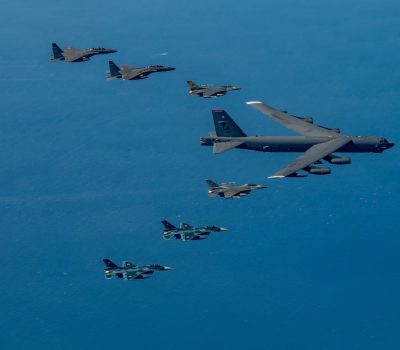Lockheed Quits Air Force Tanker Competition, But Airbus Will Go It Alone
New Report: How the Air Force Measures and Trains for Readiness Needs a Revamp
Editorial: All Together Now
Radar Sweep
Pentagon Says It Will Hold Iran Responsible for Attacks on US Troops
The Defense Department ratcheted up its rhetoric against Iran on Oct. 23, saying it will hold Tehran ultimately responsible for a spate of recent drone and rocket attacks on American troops in the Middle East. While the Pentagon does not have information that the government of Iran “explicitly ordered” the attacks on U.S. forces in the past week, the groups responsible for the incidents are backed by Tehran, DOD spokesperson Brig. Gen. Patrick Ryder told reporters.
More US Troops Get ‘Prepare to Deploy’ Orders as Drone Attacks Continue
After a week of escalating drone attacks on U.S. forces in Syria and Iraq, the Pentagon said Oct. 23 that more U.S. service members are getting ‘prepare to deploy’ orders that could send them to the Middle East. Separately, the U.S. is sending Patriot and THAAD batteries to the region, said Air Force Brig. Gen. Pat Ryder, a Pentagon spokesman.
Britain Is More Bark Than Bite in Indo-Pacific, Lawmakers Warn
Britain should either increase its military presence in the Indo-Pacific or curb its ambitions in the region, according to the parliamentary Defence Committee. The region is critical to Britain’s economic and security interests, and the government’s tilt toward the Indo-Pacific comes at a time of growing tension there involving a growing Chinese force.
US-Australia Space Launch Accord Likely on Agenda at Biden-Albanese Meeting
There is an expectation that this week’s first official state visit by Australian Prime Minister Anthony Albanese will be accompanied by formalizing an agreement that will allow U.S. commercial space companies to use launch from Down Under, Breaking Defense has learned. Generally speaking, official state visits are often accompanied by a package of announcements between the U.S. and its guest. Finalization of a technical safeguards agreement (TSA) between the two close partners would be an easy win, and one that several sources suggested to Breaking Defense is on the table.
Arctic Strategy Implementation Plan Calls for Enhanced Military Comms, Sensing, and PNT
The White House on Oct. 23 published the implementation plan for its 10-year Arctic strategy, including new directives for the Defense Department to bolster security and deter adversary activity in the region. The document follows the publication of the Biden-Harris administration’s strategy, released in 2022, that outlined four pillars related to emerging issues in the Arctic—one of which called on the Pentagon to develop capabilities for enhanced military operations.
Space Force Identifying Priorities for Modernizing Spaceports
The need to modernize U.S. spaceports has been discussed for years, but major upgrades have yet to materialize. With $1.3 billion in projected funding for spaceport improvements, the Space Force is now trying to move these plans forward, identifying the most critical areas needing attention in the near-term. “There’s a significant effort to define what we need to be able to support the capacity and the pace of launch that our nation needs,” said Brig. Gen. Kristin Panzenhagen, program executive officer for assured access to space and director of launch and range operations of Space Systems Command.
US State Department Approves Potential Missiles Sales to UK, Finland, Lithuania
The U.S. State Department approved three potential arms sales to the United Kingdom, Finland and Lithuania, the Pentagon said on Oct. 23 as Ukraine's European allies continue to stock up on munitions after flooding Kyiv with donations. European demand for U.S. weaponry is soaring, but instead of big-ticket items like jets and tanks, shopping lists are focused on cheaper, less-sophisticated items such as shoulder-fired missiles, artillery, and drones that have proven critical to Ukraine's war efforts.
Russia’s Air Force ‘Eating Into’ Aircraft Lifespans, with No Easy Solution
As the ground war in Ukraine continues to grind ahead of the winter months, the Russian Aerospace Forces (VKS) are experiencing falling availability rates with their existing fleet of combat aircraft. The culprit is a combination of a high number of losses of fixed-wing aircraft combined with a drop in mission-capable rates due to the higher-than-normal number of flight hours being flown by those aircraft remaining.
5 Reasons Military Transport Planes Have High Wings
When it comes to aircraft design, there's no one-size-fits-all approach. While most planes today usually have a standard “tube and wing” design, the configuration and placement of the wings are tailored to meet specific needs. One design element that often sets military transport planes apart is the high-wing configuration.




